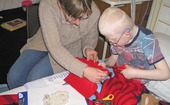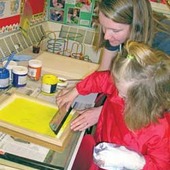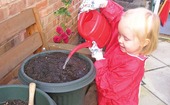education provides a way to keep up with work - and also smooths the way
for reintegration with their peers. By Jenny Craigen

Last summer I retired after working for nine years, under the direction of Somerset County Council, as the teacher at the Children's Education Unit, the hospital school at Musgrove Park Hospital in Taunton, Somerset. This work, of course, continues in the capable hands of my successor. Like me, she is finding this an enjoyable and privileged role.
Statutory guidance from the Department for Education states that local authorities must arrange suitable education for children who are unable to attend school because of their health. The authority must provide appropriate education as soon as it is clear that a child will be away from school for 15 days or more, whether consecutive or cumulative. This 'alternative provision', as it is has been known since 2013, should prevent them from slipping behind their peers and allow them to reintegrate successfully back into school as soon as possible, acquiring appropriate qualifications as needs be.
Musgrove Park Hospital has 35 beds on its paediatric ward and, as a teacher, I worked with as many four- to 16-year-olds as possible, giving priority to those patients with ongoing chronic or long-term conditions - for example, cancer, leukaemia, cystic fibrosis, juvenile arthritis, anorexia and chronic fatigue, as well as a number of endocrine disorders. School was open five mornings a week during term time.
All in all, this was varied, enjoyable work, which I feel privileged to have experienced. The challenges were many: we were presented with the most diverse ability range from each end of the spectrum. This demanded a lot of quick thinking on your feet, preparing lessons and learning materials in a very short space of time.
We had to be extremely flexible when medical plans changed in the course of a morning, we worked with children in pain, and comforted parents who were distressed.
There was, occasionally, the very sad death of a child one had worked with regularly for three years or more. But the rewards were also manifest. Most children get better and wave goodbye with a smile, while those who have to return more than once can be heard to say, 'Oh good! I can go to that great hospital school! It was well cool last time!' That in itself made the job worthwhile.
DAY TO DAY
 My day began at 8.30am when I took handover from the senior nurse on duty. I would be informed about which children had been admitted since the day before, who was going to surgery that morning, who was too unwell, and who was going home. School had to be fitted in around surgery, medication, blood tests, X-rays and other treatments.
My day began at 8.30am when I took handover from the senior nurse on duty. I would be informed about which children had been admitted since the day before, who was going to surgery that morning, who was too unwell, and who was going home. School had to be fitted in around surgery, medication, blood tests, X-rays and other treatments.
Next, I would meet the patients, and negotiate the morning's work. For children coming in for planned surgery (tonsillectomy, appendectomy, the fixing of a broken arm sustained on the trampoline), or for various other conditions requiring them only to stay a short time, I'd ask what work they enjoyed doing at school, or what they felt they needed some extra help with.
We discussed whether they felt able to come to our school room at the end of the ward, or whether it would be better for them to work in bed. For long-term or 'returning' children, I would have had telephone or e-mail contact with their teachers, and these children would arrive with work that they were required to complete, or suggested areas for study.
My assistant (higher level teaching assistant) would join me at 9am and we would plan and share out the work between us, with maybe one of us working with up to four children in the school room and the other working with another four or more at individual bedsides. Where possible, we would group children of the same age or ability, but most of the work was delivered on a one-to-one basis.
We had to be careful about cross-infection and not mix children with compromised immunity (for example, those receiving chemotherapy) with those who may carry infection. In addition, we had to ensure that all books and equipment were wiped clean after use so that infection was neither transmitted nor acquired. We had extensive up-to-date teaching resources with which to deliver the National Curriculum - books, laptops, software, internet access, and equipment for the practical aspects of maths, science, art and design technology, and a small garden where we grew vegetables and flowers.
It wasn't all academic subjects. I felt a duty to provide enrichment just as in any other school, so Fridays were 'Fun Fridays' and we would do art, gardening, music or cooking. Children would bring in their own CDs and we would all listen and enjoy the latest tracks, while parents could either drink coffee or join in the activities.
FAMILIAR AND REASSURING
 Friends at dinner parties would often ask me, 'So what's the purpose behind it all? I mean, if they're in hospital, they must be ill, surely? Do we really need to inflict school on them?'
Friends at dinner parties would often ask me, 'So what's the purpose behind it all? I mean, if they're in hospital, they must be ill, surely? Do we really need to inflict school on them?'
'Yes, yes, yes!' I would reply. Apart from the statutory guidance, which outlines the child's entitlement and the local authority's legal requirements, I feel the hospital school experience is essential. The atmosphere is extremely rarefied. For some children, it is unlike anything else encountered before, scary and sometimes painful. Hospital schools have a therapeutic as well as academic function. As well as being a helpful distraction from pain and anxiety, school is familiar, safe and somehow reassuring. The aim is to restore a bit of normality.
Most children have a parent with them in hospital and the opportunity exists to share in learning new concepts or simply to demonstrate ability in the more familiar. Parents were encouraged to read with children in the afternoons when school was closed, or to continue with unfinished work. They would often comment that the hospital school had raised their child's self-esteem and confidence, as well as helping them cope with the trauma of hospitalisation.
My brief was to cater for four- to 16-year-olds, but they could be as young as three or even two-and-a-half. If they were recently diagnosed with a long-term or chronic condition and had a long treatment road ahead of them, I would bend the rules a little so that when the time came for them to begin in the Foundation Stage, they would have some familiarity with numbers and letters and have some understanding of the social skills we bring to sharing and playing games. I worked closely with the resident play team and we devised complementary activities for these children.
Some children, on leaving hospital, were not quite fit enough to return to school and it was then I would call on colleagues from Somerset Medical Tuition, of which the hospital unit was a part, and arrangements would be made for the child either to receive home tuition or to attend classes at the tuition unit nearest to where they lived, with a view to reintegration as soon as possible (see box).
CASE STUDY: CLARA
 With a late August birthday, Clara was just four when she began in Reception. Two days later, she was diagnosed with a metastatic medulloblastoma tumour in her brain.
With a late August birthday, Clara was just four when she began in Reception. Two days later, she was diagnosed with a metastatic medulloblastoma tumour in her brain.
She went to Frenchay Hospital in Bristol for surgery and began a course of high-dose chemotherapy there. She then transferred to Musgrove Park Hospital, Taunton, to continue chemotherapy, before returning to Bristol Children's Hospital for six weeks of daily radiotherapy, and then back to Taunton for maintenance chemotherapy. This whole process took about nine months, and during this time Clara received educational input at all three hospitals.
In Taunton, we liaised with her Reception class teacher about work she was missing at school, topics being covered and so on. Clara loved books and was soon fully proficient with letters and sounds.
When she was not an in-patient at Musgrove, she received three hours per week of home tuition for three months from one of the medical tuition staff. Again, liaising with the school, as well as following the school's plans for numeracy and literacy, she did project work on houses and homes, and toys through the ages.
Clara returned to school - part time at first - the following June and is now in remission and enjoying Year 2. Her National Curriculum levels are in line with her peers and above average, and no one would believe this happy, bright, sociable little girl has undergone so much.
MORE INFORMATION
Some of the hospital schools around the country are:
- Belfast Hospital School, Belfast Hospital, www.belfasthospitalschool.org.uk
- Birmingham Children's Hospital, www.bch.nhs.uk
- Bristol Royal Hospital for Children, www.uhbristol.nhs.uk
- Cambridge University Hospitals, Addenbrooke's Hospital, www.cuh.org.uk/cms/addenbrookes-hospital
- Edinburgh Royal Hospital for Sick Children, www.nhslothian.scot.nhs.uk/goingtohospital/locations/RHSC/pages/default.aspx
- Great Ormond Street Children's Hospital School, www.gosh.nhs.uk/the-childrens-hospital-school
- Royal Manchester Children's Hospital, www.cmft.nhs.uk/childrens-hospitals
- The Noah's Ark Children's Hospital, University Hospital of Wales, www.cardiffandvaleuhb.wales.nhs.uk.









